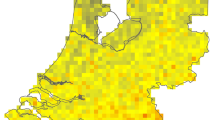Abstract
West Nile virus (Flaviviridae: Flavivirus) is a serious infectious disease that recently spread across the North America continent. A spatial analysis tool was developed on the ArcMap 9.x platform to estimate potential West Nile virus activity using a spatially explicit degree-day model. The model identifies when the virus Extrinsic Incubation Period (EIP) is completed within the vector longevity during mid-summer months. The EIP is treated as a threshold indicator of the potential for virus emergence and activity. Comparing the number of West Nile virus cases in Wyoming reported from 2003 to 2005 with model results, actual cases and predicted events of West Nile virus activity match relatively well. The model represents a useful method for estimating potential West Nile virus activity in a large spatial scale.
Similar content being viewed by others
References
Allen, J. C. (1976). A modified sine wave method for calculating degree-days. Environmental Entomology, 5, 388–396.
Centers for Disease Control and Prevention (2006). Cases of West Nile human disease. http://www.cdc.gov/ncidod/dvbid/westnile/qa/cases.htm.
Cornel, A. J., Jupp, P. G., & Blackburn, N. K. (1993). Environmental temperature on the vector competence of Culex univittatus (Diptera: Culicidae) for West Nile virus. Journal of Medical Entomology, 30, 449–456.
Day, J. F. (2001). Predicting St. Louis encephalitis virus epidemics: Lessons from recent, and not so recent, outbreaks. Annual Review of Entomology, 46, 111–138.
Dohm, D. J., O’Guinn, M. L., & Turell, M. J. (2002), Effect of environmental temperature on the ability of Culex pipiens (Diptera: Culicidae) to transmit West Nile virus. Journal of Medical Entomology, 39, 221–225.
Eidson, M., Kramer, L., Stone, W., Hagiwara, Y., & Schmit, K. (2001). Dead bird surveillance as an early warning system for West Nile virus. Emerging Infectious Diseases, 7, 631–635.
Enserink, M. (2002). West Nile’s surprisingly swift continental sweep. Science, 297(5589), 1988–1989.
Lee, J., Rowley, W. A., & Platt, K. B. (2000). Longevity and spontaneous flight activity of Culex tarsalis (Diptera: Culicidae) infected with West Equine encephalomyelitis virus. Journal of Medical Entomology, 37, 187–193.
Pruess, K. P. (1983). Day-degree methods for pest management. Environmental Entomology, 12, 613–619.
Reisen, W. K., Fang, Y., & Martinez, V. M. (2006). Effects of temperature on the transmission of West Nile virus by Culex tarsalis (Diptera: Culicidae). Journal of Medical Entomology, 43, 309–317.
Reisen, W. K., Lothrop, H. D., & Hardy, J. L. (1995). Bionomics of Culex tarsalis (Diptera: Culicidae) in relation to arbovirus transmission in southeastern California. Journal of Medical Entomology, 32, 316–327.
Reisen, W. K., Meyer, R. P., Presser, S. B., & Hardy, J. L. (1993). Effect of temperature on the transmission of western equine encephalomyelitis and St. Louis encephalitis viruses by Culex tarsalis (Diptera: Culicidae). Journal of Medical Entomology, 30, 151–60.
Turell, M. J., Rossi, C. A., & Bailey, C. L. (1985). Effect of extrinsic temperature on the ability of Aedes taeniorhynchus and Culex pipiens to transmit Rift Valley fever virus. Journal of Tropical Medicine and Hygiene, 34, 1211–1218.
Zou, L., Stout, M. J., & Ring, D. (2004). A degree-day model to predict the emergence of rice water weevil Lissorhoptrus oryzophilus from overwinter sites. Environmental Entomology, 33, 1541–1548.
Author information
Authors and Affiliations
Corresponding author
Rights and permissions
About this article
Cite this article
Zou, L., Miller, S.N. & Schmidtmann, E.T. A GIS Tool to Estimate West Nile Virus Risk Based on a Degree-Day Model. Environ Monit Assess 129, 413–420 (2007). https://doi.org/10.1007/s10661-006-9373-8
Received:
Accepted:
Published:
Issue Date:
DOI: https://doi.org/10.1007/s10661-006-9373-8




